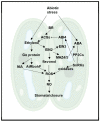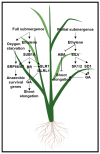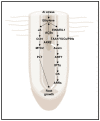To Fight or to Grow: The Balancing Role of Ethylene in Plant Abiotic Stress Responses
- PMID: 35009037
- PMCID: PMC8747122
- DOI: 10.3390/plants11010033
To Fight or to Grow: The Balancing Role of Ethylene in Plant Abiotic Stress Responses
Abstract
Plants often live in adverse environmental conditions and are exposed to various stresses, such as heat, cold, heavy metals, salt, radiation, poor lighting, nutrient deficiency, drought, or flooding. To adapt to unfavorable environments, plants have evolved specialized molecular mechanisms that serve to balance the trade-off between abiotic stress responses and growth. These mechanisms enable plants to continue to develop and reproduce even under adverse conditions. Ethylene, as a key growth regulator, is leveraged by plants to mitigate the negative effects of some of these stresses on plant development and growth. By cooperating with other hormones, such as jasmonic acid (JA), abscisic acid (ABA), brassinosteroids (BR), auxin, gibberellic acid (GA), salicylic acid (SA), and cytokinin (CK), ethylene triggers defense and survival mechanisms thereby coordinating plant growth and development in response to abiotic stresses. This review describes the crosstalk between ethylene and other plant hormones in tipping the balance between plant growth and abiotic stress responses.
Keywords: abiotic stress; ethylene; growth and defense tradeoff; hormone crosstalk.
Conflict of interest statement
The authors declare no conflict of interest. The funders had no role in the design of the study; in the collection, analyses, or interpretation of data; in the writing of the manuscript, or in the decision to publish the results.
Figures





Similar articles
-
Plant hormone-mediated regulation of stress responses.BMC Plant Biol. 2016 Apr 14;16:86. doi: 10.1186/s12870-016-0771-y. BMC Plant Biol. 2016. PMID: 27079791 Free PMC article. Review.
-
Function and Mechanism of Jasmonic Acid in Plant Responses to Abiotic and Biotic Stresses.Int J Mol Sci. 2021 Aug 9;22(16):8568. doi: 10.3390/ijms22168568. Int J Mol Sci. 2021. PMID: 34445272 Free PMC article. Review.
-
The Crosstalks Between Jasmonic Acid and Other Plant Hormone Signaling Highlight the Involvement of Jasmonic Acid as a Core Component in Plant Response to Biotic and Abiotic Stresses.Front Plant Sci. 2019 Oct 18;10:1349. doi: 10.3389/fpls.2019.01349. eCollection 2019. Front Plant Sci. 2019. PMID: 31681397 Free PMC article. Review.
-
A Functional Genomic Perspective on Drought Signalling and its Crosstalk with Phytohormone-mediated Signalling Pathways in Plants.Curr Genomics. 2017 Dec;18(6):469-482. doi: 10.2174/1389202918666170605083319. Curr Genomics. 2017. PMID: 29204077 Free PMC article. Review.
-
Signaling Crosstalk between Salicylic Acid and Ethylene/Jasmonate in Plant Defense: Do We Understand What They Are Whispering?Int J Mol Sci. 2019 Feb 4;20(3):671. doi: 10.3390/ijms20030671. Int J Mol Sci. 2019. PMID: 30720746 Free PMC article. Review.
Cited by
-
Drought Stress Amelioration Attributes of Plant-Associated Microbiome on Agricultural Plants.Bioinform Biol Insights. 2024 Mar 8;18:11779322241233442. doi: 10.1177/11779322241233442. eCollection 2024. Bioinform Biol Insights. 2024. PMID: 38464334 Free PMC article. Review.
-
Time-Series Transcriptome Analysis Reveals the Molecular Mechanism of Ethylene Reducing Cold Sensitivity of Postharvest 'Huangguan' Pear.Int J Mol Sci. 2023 Mar 10;24(6):5326. doi: 10.3390/ijms24065326. Int J Mol Sci. 2023. PMID: 36982404 Free PMC article.
-
GmHXK2 promotes the salt tolerance of soybean seedlings by mediating AsA synthesis, and auxin synthesis and distribution.BMC Plant Biol. 2024 Jun 27;24(1):613. doi: 10.1186/s12870-024-05301-3. BMC Plant Biol. 2024. PMID: 38937682 Free PMC article.
-
Decrypting the multi-functional biological activators and inducers of defense responses against biotic stresses in plants.Heliyon. 2023 Feb 18;9(3):e13825. doi: 10.1016/j.heliyon.2023.e13825. eCollection 2023 Mar. Heliyon. 2023. Retraction in: Heliyon. 2024 Dec 18;11(1):e41349. doi: 10.1016/j.heliyon.2024.e41349. PMID: 36873502 Free PMC article. Retracted. Review.
-
Ethylene promotes SMAX1 accumulation to inhibit arbuscular mycorrhiza symbiosis.Nat Commun. 2025 Feb 27;16(1):2025. doi: 10.1038/s41467-025-57222-w. Nat Commun. 2025. PMID: 40016206 Free PMC article.
References
-
- Chapin F.S. Integrated Responses of Plants to Stress. BioScience. 1991;41:29–36. doi: 10.2307/1311538. - DOI
-
- Heil M., Walters D., Newton A., Lyon G. Induced Resistance for Plant Defense. John Wiley & Sons; Chichester, UK: 2014. Trade-offs associated with induced resistance; pp. 171–192.
-
- Neljubow D. Uber die horizontale Nutation der Stengel von Pisum Sativum und einiger anderen Planzen. Bot. Centralbl. Beih. 1901;10:128–139.
Publication types
Grants and funding
LinkOut - more resources
Full Text Sources
Research Materials

